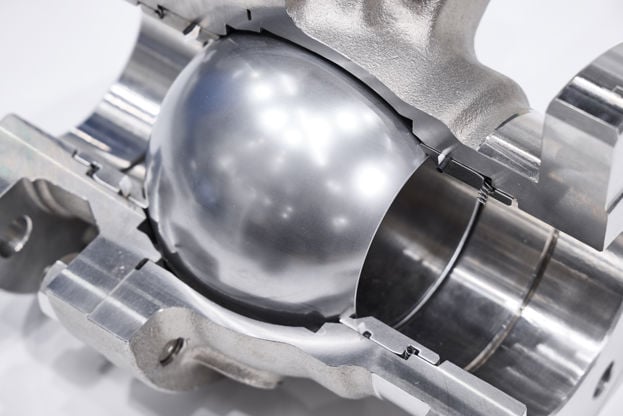The energy transition: At the heart of the matter?
The outlook on energy transition is challenging to say the very least. It is important to explore what flow control technologies can bring to the table to address the many pressing challenges that must be faced. Valve solutions have a vital role in many crucial
applications such as sustainable aviation fuel (SAF) production, carbon capture, utilisation and storage (CCUS), hydrogen, and plastics liquefaction – all segments which are directly contributing towards cutting carbon footprint and curbing global warming. Piotr Kulisz and Andreas Pischke, Valmet Flow Control business line, explore the critical role of flow control technologies in the energy transition.

International Renewable Energy Agency (IRENA) reporting states that limiting global warming to 1.5°C requires cutting carbon dioxide (CO2) emissions by around 37 gigatonnes (Gt) from 2022 levels and achieving net-zero emissions in the energy sector by 2050. This in itself is a huge task.
A 1.5°C compatible pathway requires an urgent and wholescale transformation of the way societies consume and produce energy. Global investments across all energy transition technologies reached a record high of US$1.3 trillion in 2022, yet fossil fuel capital investments were almost twice those of renewable energy investments. Consequently, it is imperative that the oil and gas, refining and chemical industry work hard and fast towards climate sustainable operations.
Technology companies are stepping up
In supporting this endeavour, despite current challenges, leading technology companies have established R&D programmes, where along with their ecosystems, they can come together to innovate, renew and aid their customer industries in the shift to carbon neutrality.
Circularity is at the core of these programmes and targets are closely connected to achieving a carbon neutral future. The following part of this article will focus on flow control technologies that enable the SAF, CCUS, hydrogen, and plastics
liquefaction segments to contribute towards this objective.
Battling sky-high aviation emissions
While electric vehicles are expected to dominate road transport and methanol marine transport, the aviation sector holds the most promise for bio-refining and the subsequent shift to SAF. In 2022, IATA estimated global SAF production at approximately 300 - 450 million litres (l) (approximately 0.15% of total global jet fuel consumption. By 2030 it is projected to reach 30 billion l/y and further to 449 billion l/y by 2050 i.e. around 65% of the total global jet fuel consumption.
Turning waste into jet fuel
There are currently nine certified production pathways to produce SAF and many of them include processing units similar to conventional refining – for example hydro-treating,
hydro-cracking, isomerisation, and fractionation.
Diverse feedstocks including biomass, vegetable oils, animal fats and used cooking oils bring their own challenges to valves. Valves with special alloys and hard facing and firesafe designs are required to ensure safe and uninterrupted performance.
Dehydration is an integral part of some of these processes. To secure long term reliability, metal-seated ball valves with unique closed and scraping seat designs and high cycle actuators, coupled with high-capacity intelligent controllers, are strongly recommended. Triple-offset eccentric disc valves with metal seats protected from the shear force of the process fluid and mechanically induced tightness can also be a viable option.
Capturing new opportunities
Flow control and high-quality valves also play an important role in modern carbon capture technologies. Each process to separate CO2 has its own set of challenges whether for post- and pre combustion or oxyfuel combustion. Low temperature challenges occurring in cryogenic separation require an additional focus on valve design and material selection.

New but field proven application-based solutions
Many of the CO2-removal processes are known and have been applied for decades in the refinery industry, whether for production of hydrogen by steam methane reforming or for ethylene production by steam cracking.
The widespread amine-based absorption with its amine regeneration units also presents valves with challenges such as corrosion, high temperatures and pressures. High concentrations of H2S and CO2 require material selection
according to NACE. Depending on the absorber pressure, the pressure drop across the valve can reach up to 170 bar. Two phase flow, flashing or outgassing can be expected in this application.
Performance in severe service
Severe service control valves incorporating anti cavitation trims, either multi-stage disc stacks or self- flushing Q-trims have proven effectiveness in noise attenuation at source. Utilisation of evolving 3D printing technologies will allow these capabilities to be enhanced. At the same time, angle pattern globe valves or flow- to-open eccentric plug valves have been proven in flashing service.
Swing adsorption technologies mainly used to purify hydrogen in refineries now get more attention also in purifying carbon dioxide instead of releasing it straight into the atmosphere – but rather preparing it for further utilisation.
Pressure swing adsorption (PSA) requires highly reliable switching valves to remain gas-tight after hundreds of thousands of cycles at pressures of up to 100 bar. Valves in thermal swing adsorption (TSA) see temperatures of up to 400°C during the adsorbent regeneration phase and must be capable of maintaining the same tightness under these conditions. High performance butterfly and ball valves have been proven in use in thousands of PSA and TSA operations around the world.
New approaches in every turn
Half of the carbon emissions in a refinery come from the production, with the other half from power generation. This requires new carbon dioxide capture systems that separate the carbon dioxide from the flue gases of heating systems powered by fossil fuels or, in the case of gas turbines, from the exhaust gases of the turbines.Next to amine-based absorption there might be other technologies applied, such as oxyfuel combustion or pre-combustion technologies. Cryogenic separation should also not be forgotten, which makes sense where the CO2 is needed in liquefied state.
Hydrogen in high demand
Hydrogen is playing an increasing role in the Power-to-X value chain, regardless of whether the hydrogen is produced in a refinery using carbon capture technology as blue hydrogen, or by electrolysis as green hydrogen.
Hydrogen presents a unique set of challenges to valves due to its characteristics. It is highly flammable, which obviously requires a fire-safe valve design. Additionally, the extremely small molecule size makes maintaining the valve’s internal tightness and controlling fugitive emissions more challenging. Hydrogen is known to significantly deteriorate some material properties, resulting in a reduction of damage tolerance for some valve components. Liquid hydrogen service also involves extremely low temperatures.
Not affected by extreme temperatures
Once again, fire-safe high performance butterfly valves capable of handling high temperatures of up to 800°C, as well as special cryogenic seat designs and special extensions including high yield-strength shafts, and low emission packing designs, have proven themselves in these conditions.
Re-evaluating plastics
Plastic is ubiquitous, and it is hard to envision modern life without it. Global production has exceeded 400 million t, with Europe alone contributing nearly 60 million t. These staggering figures highlight the scale of production, but they also draw attention to the significant threats posed by unchecked plastic production and poor waste management to the climate, the natural environment, and human health.

Figure 2. It is important for butterfly valves to undergo cryogenic testing to ensure performance in extreme temperatures.
Changing attitudes drive changing practices
There is an ongoing cultural shift concerning how societies perceive this issue and are actively seeking ways to reduce the production of new plastic from fossil sources, minimise its disposal in natural environments, and increase recycling efforts. This shift aims to reduce the carbon emissions associated with the pervasive presence of plastic in our daily lives.
Plastics liquefaction is one of the pivotal methods for recycling, which will play an increasingly significant role over time. From a functional perspective, similar to bio-refining, these liquefaction processes require valves that handle diverse challenging feedstock and offer precise control, emergency shutdown capabilities to ensure plant safety, as well manual or automated on/off functionality that provides reliable, sustainable process performance and tight shutof.

Figure 3. Unique metal matrix composites perform well in sticky and abrasive situations.
Addressing the plastics crisis with recycling
Regardless of the recycling technology – be it pyrolysis, gasification, depolymerisation, purification, or hydrothermal – all involve high (and sometimes extreme) temperatures and pressures, posing significant challenges for valve selection. These challenges include handling the viscosity of the medium, the presence of hard abrasive particles that can damage or block valve components, and the corrosiveness of the media.Pyrolysis processes are frequently cited as the technology poised to dominate chemical recycling. While these processes differ in specifics, they commonly present similar challenges.
Valves for sticky situation
Plastic melt valves represent a critical application. The management of sticky fluids containing hard particles, temperatures up to 450°C, and a pressure class of ANSI 1500, makes heavy-duty ball valves with a hard-coated scraping seat design the optimal choice.The gases released during pyrolysis are channelled to the subsequent stages of oil production. However, other byproducts formed in the reactors must also be removed. Metal matrix composite valve constructions necessary for removing these products from the reactor bottom, though operating at relatively low pressure, can withstand temperatures up to 650°C (depending on the technology), and handle media containing hard solid particles.
Technology is at the heart of change
At the heart of every application discussed in this article are valves that regulate the flow of media throughout the veins and arteries of the process. The performance of these valves directly affects the performance of the entire process itself. In conclusion, irrespective of the nature and challenges posed by the multiple prevalent energy transition technologies of today, field proven flow control solutions are available to address these reliably, efficiently, and sustainably. Through deep understanding of the processes involved, intuitiveness and continued innovation, leading technology providers can and will continue to pursue new growth opportunities arising from this energy transition.
Originally published in Hydrocarbon Engineering magazine - EnviroTech 2024 issue.

Andreas Pischke
Global Industry Manager
Valmet Flow Control business line

Piotr Kulisz
Director, service, Europe
Valmet Flow Control business line





